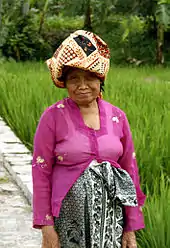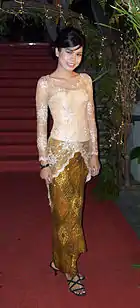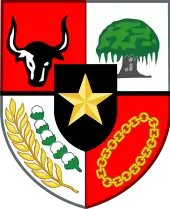Kebaya
A kebaya (Javanese: ꦏꦼꦧꦪ; Jawi: کباي; Pegon: كبيا) is a traditional blouse-dress combination that originated from the court of Majapahit in Java.[1][2] It is traditionally worn by women in Indonesia, Malaysia, Singapore, Brunei, southern Thailand and southern Philippines.
 The classic Javanese kebaya is a sheer delicate tight-fitting blouse worn over kemben torso wrap of batik cloth, as shown here worn by Gusti Kanjeng Ratu Hayu, Princess of Yogyakarta | |
| Type | Traditional Blouse-dress |
|---|---|
| Place of origin | Indonesia[1][2][3][4][5] and Malaysia[6][7][5][8] |
Kebaya is described as women's upper long-sleeved clothes.[9] It is sometimes made from sheer material such as silk, thin cotton or semi-transparent nylon or polyester, adorned with brocade or floral pattern embroidery. A kebaya is usually worn with a sarong or a batik kain panjang — a long cloth wrapped around the waist,[9] or other traditional woven garment such as ikat, songket with a colorful motif.
The kebaya is officially recognised as the national costume of Indonesia,[10] although it is more accurately endemic to the Javanese, Sundanese and Balinese peoples.[11] In Malaysia, it is one of the traditional costumes of the Malay, Baba Nyonya, Chetti Melaka, Jawi Pekan, Kristang and Sam-sam communities.[12]
Etymology
While "kebaya" has a folk etymology from Arabic: قباء qabāʼ "a long-sleeved upper garment",[13][14] the term is probably actually derived from عباءة ʽabāʼah, a cloak or loose outer garment. The term was then introduced into the archipelago through the Portuguese intermediary loanword cabaya during the 16th century.[15][16]
History
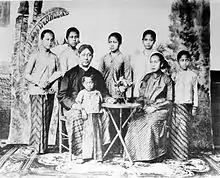
The earliest form of Kebaya believed was originates in the court of the 15th century Javanese Majapahit Kingdom,[1] as a means to blend the existing female Kemben, torso wrap of the aristocratic women, to be more modest and acceptable. Prior to Islamic influence, Javanese already recognised several terms to describe clothing, such as kulambi (clothes), sarwul (pants), and ken (kain or long fabric wrapped around the waist).[15] During the last period of Majapahit kingdom, Islamic influence began to grow in coastal Javanese towns, thus there was a need to adapt the Javanese fashion to the newly adopted Islam religion. The tailored blouse, often made from delicate sheer fabrics, were worn over kemben torso wrap to cover the back, shoulders and arms, in order for court ladies to appear more modest. Perhaps the kebaya served to provide body coverage to court women and elites in reactions to Islamic strictures on modesty that requires women to cover their body.[1] The adoption of a more modest fashion was attributed to the Islamic influence upon the archipelago.[15] Aceh, Riau and Johor Kingdoms and Northern Sumatra adopted the Javanese style kebaya as a means of social expression of status with the more alus or refined Javanese overlords.[2]
Another opinion suggests that kebaya was originated from the Portuguese Malacca (1511–1641)[7][8][17] in Malay peninsula. Kebaya is believed to be introduced from the Middle East by the Portuguese to Malacca[6] and the rest of Southeast Asia after capturing Malacca in 1511. It was the dress worn by the Portuguese women in the settlement. Nevertheless, some stated that the kebaya in Java predates Portuguese arrival in the archipelago. When Portuguese tried to assume the spice trade in Indonesia in the early 16th century, some women in Java already wore kebaya on their upper body.[1] Some sources also state that kebaya is in fact a Malay dress, that became a favourite among the Portuguese settlers in Malacca and adopted it as one of their costumes. During this time, Malay women wore their kebaya that was fastened by "keronsang" with matching sarong.[17] Thus, the Malays in Malacca have been wearing kebaya for a long time.[18] The Malay kebaya is known as Baju Kebaya Labuh (also known as "Baju Belah Labuh Besar"), is a kind of loose dress, believed to come from the word "Al Akibiya Al Turkiyya", a kind of loose dress originated from Ottoman Turkey. It was also known as "Baju Belah Labuh Besar" (long baggy dress) probably because of it loose figures with the length of the dress reaches the ankles, only an inch from the bottom of the sarong.[8] This dress is also very similar to the Egyptian "djubba". Due to its resemblance, some considered kebaya to have connections with clothings from the Middle East. Based on these assumptions, it can be considered that this dress is one of the oldest women's clothing in the Malay world, especially in the Malay Peninsula. [17]
How the kebaya came into use in Java remains unclear since several foreign cultures possibly responsible for the introduction of this clothing style into the island.[1] Indonesia has traded with China, India and the Middle East since the middle of the first millennia, which possibly transmitted the long-sleeved dress through imports. Foreign influences have been suggested, such as Ming tunic wore by Chinese settlers between 1300 to 1600,[6] possibly led to the creation of kebaya in Javanese Majapahit court and Malaccan Malay court[8]. Indeed Majapahit court (1293–1500) was the first that formally adopt the kebaya.[2]. Concurrently, the emergence of kebaya as the traditional costume of the Javanese and the Malays originated from the integration of the style of Chinese Ming dynasty, the Arab Muslims and the Portuguese. Thus, there are various of styles throughout the archipelago with each named after its wearer, location or modification. [8]
The name of Kebaya as a particular clothing type was noted by the Portuguese when they landed in the archipelago. Kebaya is associated with a type of blouse worn by Indonesian women in the 15th or 16th century.[18] Prior to 1600, kebaya in Java were considered as a reserved clothing to be worn only by royal family (ningrat), aristocrats (bangsawan) and minor nobility, in an era when peasant men and many women walked publicly bare-chested. Later on, the kebaya also being adopted by commoners, the peasant women in Java. Up until this day in rural agricultural villages of Java, farmer women still uses simple kebaya, especially among elderly women. The everyday kebaya worn by peasant were of simple materials and secured with simple pin or peniti (safety pin).
Slowly it naturally spread to neighbouring areas through trade, diplomacy and social interactions to Malacca, Bali, Sumatra, Borneo, Sulawesi, Sulu and Mindanao.[19][20][21] Javanese kebaya as known today were noted by Stamford Raffles in 1817, as being of silk, brocade and velvet, with the central opening of the blouse fastened by brooches, rather than button and button-holes over the torso wrap kemben, the kain — an unstitched wrap fabric several metres long, erroneously termed sarong in English (a sarung, Malaysian accent: sarong) which is stitched to form a tube.
The earliest photographic evidence of the kebaya as known today date from 1857 of Javanese, Peranakan and Oriental styles.[2] By the last quarter of the 19th century, kebaya had been adopted as the preferred women's fashion of the tropical Dutch East Indies, either worn by native Javanese, European colonials and Indos, also Chinese Peranakans.[22] After hundreds of years of regional acculturation, the garments have become highly localised expressions of ethnic culture, artistry and tailoring traditions.
.jpg.webp)
After the Independence of Indonesia in 1945, Indonesian first president, Sukarno chosen kebaya as the national costumes for Indonesian women.[23] Subsequently, kebaya are encourage to be used by Indonesian first ladies, the wives of state officials, and also common Indonesian women during official functions and events. However, the more democratic official appointment of kebaya as the national costumes was actually took place in 1978. The determination of Indonesia's national dress originated from a 1978 conference and workshop in Jakarta, which was attended by representatives of all provinces in Indonesia. In this workshop, fashion and cultural observers gathered to determine one national dress of the republic. From many types of clothing in Indonesia, at that time, there were four candidates for national dress, namely kemben, kebaya, baju kurung, and baju bodo. At that time kemben is most strongly associated with Java, baju kurung with Sumatra, as baju bodo with Sulawesi and Eastern Indonesia. Kebaya is considered as the most neutral and commonly accepted candidate. Kebaya has always been a part of people's lives in every region in Indonesia for ages, even during the colonial era, the early independence era to the modern era in the present. Thus it has become the official national costumes of Indonesia.[24]
By 2019, there is a surge of kebaya popularity among modern Indonesian women. At MRT Station in Jakarta, a number of kebaya enthusiasts campaigned to promote kebaya as everyday fashion for work as well as for casual clothing on weekend. The movement sought to make wearing kebaya the norm among Indonesian women.[10] After quite a long time losing to compete with Western and Muslim fashion, kebaya saw a revival in 2019 in Indonesia, as rising numbers of kebaya enthusiasts proudly don the kebaya in public space. Kebaya began to come out of its "cultural cage" — namely wedding receptions and other traditional events — to public places. Kebaya is starting to appear again in government and private offices, at bus stops, commuter train stations, Transjakarta shelters, in cafes, and malls in Jakarta and other areas. During Hari Kemerdekaan (independence day) ceremony on 17th August 2019 in Merdeka Palace, kebaya being proudly worn by VVIP and elites of Indonesian society; namely from first lady, female state ministers, to the wives of state officials and distinguished guests.[25]
Costume components
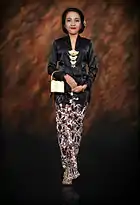
The quintessential kebaya is the Javanese kebaya as known today is essentially unchanged as noted by Raffles in 1817.[26][27] It consists of the blouse (kebaya) of cotton, silk, lace, brocade or velvet, with the central opening of the blouse fastened by a central brooch (kerongsang) where the flaps of the blouse meet, wore over kain.
- Kebaya blouse
- The kebaya blouse is commonly semi-transparent and traditionally worn over the torso wrap or kemben. Kebaya blouse can be tailored tight-fitting or loose-fitting, made from various materials, from cotton or velvet, to fine silk, exquisite lace and brocade, decorated with stitching or glittering sequins.
- Undergarments
- Because many of kebaya fabrics are made of fine, sheer and semi-transparent materials, there is a need to wear undergarments beneath to cover the breasts for modesty purpose. Traditionally, Javanese women wearing kemben torso wrap beneath their kebaya. Today however, the undergarment use under kebaya usually either corset, bra or camisole with matching colour. The more simple and modest undergarment wore by common village women, usually elderly women, is called kutang, which is a bra-like undergarment made from cotton.
- Kerongsang brooch
- Traditional kebaya had no buttons down the front. To secure the blouse openings in the front, a decorative metal brooch is applied on the chest. It can be made from brass, iron, silver or gold, decorated with semi-precious stones. A typical three-piece kerongsang is composed of a kerongsang ibu (mother piece) that is larger and heavier than the other two kerongsang anak (child piece). Kerongsang brooch often made from gold jewelry and considered as the sign of social status of aristocracy, wealth and nobility, however for commoners and peasant women, simple and plain kebaya often only fastened with modest safety pin (peniti).
- Kain sarong or skirt
- Kain is a long decorated clothes wrapped around the hips, secured with rope and wore as a kind of sarong or skirt. The skirt or kain is an unstitched fabric wrap around three metres long. The term sarong in English is erroneous, the sarung (Malaysian accent: sarong) is actually stitched together to form a tube, kain is unstitched, requires a helper to dress (literally wrap) the wearer and is held in place with a string (tali), then folded this string at the waist, then held with a belt (sabuk or ikat pinggang), which may hold a decorative pocket. In Java, Bali and Sunda, the kain is commonly batik which may be from plain stamped cotton to elaborately hand-painted batik tulis embroidered silk with gold thread. In Lampung, the kain is the traditional tapis, an elaborate gold-thread embroidered ikat with small mica discs.[28] Sumatra, Flores, Lemata Timor, and other islands commonly use kain of ikat or songket. Sumba is famous for kain decorated with lau hada: shells and beads.[29]
Variants of Kebaya elements
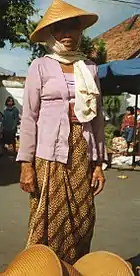
- Collars
- In the aspect of collar or neck cut, there are two main varieties; the V shaped collar (Javanese, Kartini, Balinese, and Encim or Peranakan) and the square collar cut (Kutubaru). The Sundanese and modern kebaya has U shaped collar edged with brocade and often decorated with sequins. Modern kebaya also might apply various shapes and curves of collars.
- Fabrics
- In fabrics aspect, the blouse known as baju kebaya may be of two main forms: the transparent or semi-transparent straighter cut blouse of Java, Bali, or the more plain and modest kebaya of Sumatra and Malaya.
- Cut and fittings
- In the cut aspect, two main varieties are; the more tightly tailored Java, Bali and Sunda kebaya, and the loose-fitting modest kebaya wore by more pious Muslim women, usually wore with hijab. The more Islamic compatible, a plainer and modest baju kurung is a loose-fitting, knee-length long-sleeved blouse worn in the more Muslim areas, including the former Kingdom of Johor-Riau (now Malaysia), Sumatra, Brunei and parts of coastal Borneo and Java.
Varieties in Indonesia
Kartini kebaya
The type of kebaya used by aristocratic Javanese women, especially during the lifetime of Raden Ajeng Kartini, circa 19th century.[30] Often the term "Javanese kebaya" is synonymous with the kebaya Kartini, although slightly different. Kebaya Kartini usually made from a fine but non-transparent fabrics, and white is a favoured colour. Basic Kebaya Kartini might be plain. The adornment is quite minimal, only stitching or applied laces along the edges. The V-shaped collar cut of this type of kebaya is quite similar to the Peranakan Encim kebaya, however it is distinguishes by its distinctive fold on the chest. Another feature of the Kartini kebaya is the length of the kebaya that covers the hips, and the collar folds with a vertical line shape, which creates the tall and slender impression of the wearer.[31] The Kartini-style kebaya inspired the cut and style of Garuda Indonesia's flight attendants' uniform.
Kutubaru kebaya
The basic form of Kutubaru kebaya is quite similar to other types of kebaya.[30] What distinguishes it is the additional fabric called bef to connect the left and right side of the kebaya in the chest and abdomen. This create a square or rectangle shaped collar. This type of kebaya was meant to recreate the look of unsecured kebaya wore over matching kemben (torso wrap) undergarment. Kebaya Kutubaru is believed to be originated from Central Java.[32] Usually to wear this type of kebaya, stagen (cloth wrapped around the stomach), or rubber-enforced black corset is wore under the kebaya, thus the wearer will look more slender.[31]
Javanese kebaya
This type of kebaya from Java has a simple shape with a V-neck. This straight and simple cut gives an impression of simple elegance. Usually a Javanese kebaya is made of semi-transparent fine fabric patterned with floral stitching or embroidery, sometimes adorned with sequins. Other fabrics might be used, including cotton, brocade, silk and velvet. The semi-transparent kebaya is worn over matching underwear, either corset, bra or camisole.[31]
Solo or Keraton kebaya
Solo kebaya or also known as Keraton kebaya,[33] is an aristocratic kebaya typically worn by noble women of the court of Surakarta Hadiningrat kingdom of the Solo city in Central Java. Solo kebaya usually use dark coloured fabrics, with black velvet as the most favoured material. The edge around the sleeves and along the collar up to the front opening and bottom edges are decorated with golden or silver beads and sequins. The cut of Solo kebaya is longer than common Javanese kebaya, usually up to the knee of the wearer. Solo kebaya is known for its elegance, and usually used for Javanese Solo Putri style wedding dress.[34]
Sundanese kebaya
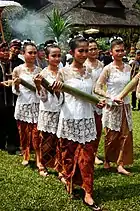
Tight-fitting brocade Sundanese kebaya allows more freedom in design, and much applied in modern kebaya and wedding kebaya in Indonesia. The semi-transparent fabrics is patterned with floral stitching or embroidery. The main difference with other kebaya style is the U collar neckline, often applying broad curves to cover shoulders and chest. Another difference is the extra long lower parts of kebaya, with hanging edges which covers hips and thigh. The contemporary wedding kebaya dress even has sweeping long train.
Bandung kebaya
This kebaya design originated from the city of Bandung in the 1950s. The distinctive feature of this kebaya is the kerah setali (shawl collar) that folds up to the chest. The cut is also unique in that the back is shorter than the front. The Bandung kebaya design is a very short kebaya with a length only up to the waist or a few centimetres below the waist, exposing the curved hips of the wearer. This rather daring design was meant for young maiden and considered as one of the most chic kebaya variant. It is often applied in modern kebaya fashion, unorthodoxly combined with tight kain sarong, pants or short skirts. Kebaya Bandung usually uses a shawl collar that forms a V-neckline with a slit on the front secured with buttons. The material used for the Bandung Kebaya is brocade combined with a long batik cloth.[33][35]
Balinese kebaya
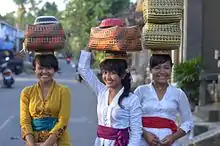
Balinese kebaya is quite similar to Javanese kebaya, but slightly different. The Balinese kebaya usually has V neck line with folded collar sometimes decorated with laces. They are usually tight-fitting made with colorful semi-transparent or plain fabrics either cotton or brocade, patterned with floral stitching or embroidery. Unlike traditional Javanese kebaya, Balinese kebaya might add buttons in the front opening, and kerongsang brooch is seldom used. The main difference is Balinese kebaya add obi-like sash upon kebaya, wrap around the waist.[31]
The Balinese kebaya is part of busana adat or customary dress, Balinese women are required to wear kebaya during Balinese Hindu rituals and ceremony in pura. White kebaya are favoured for Balinese religious rituals. Other than religious ceremony, contemporary Balinese women also often wear kebaya for their daily activities. Because most Balinese people are Hindus, the Balinese kebaya usually has shorter sleeves compared to Javanese kebaya.
Madurese kebaya
Kebaya Madura is the style of kebaya from the island of Madura off coast of East Java. It is also known as kebaya rancongan, it has a characteristic on the neck collar in the V shape. In addition, this kebaya is also equipped with jewelry to cover the neck and chest. The length of this kebaya is only up to the waist and tapers at the bottom. Kebaya Madura shows the curves of wearer's body, to create elegant silhouette.[36]
Malay or Labuh kebaya
Kebaya Labuh is a style of Malay kebaya which is quite similar to baju kurung. This type of kebaya used in Sumatra, particularly on Malay-populated provinces, including North Sumatra, Riau, the Riau Islands, Jambi, the Bangka Belitung Islands, and South Sumatra. Kebaya labuh is actually more specifically associated with the Melayu Lingga culture.[37] The kebaya labuh consists of a loose, knee-length tunic and is usually made of semi-transparent fabrics. The central opening of the blouse-dress is usually wrapped by brooches and is traditionally worn with kemban, along with a sarong or songket around the hips.[4]
Batak kebaya
Batak kebaya are variant of kebaya adopted by Batak people of North Sumatra. Traditionally Batak people wear ulos clothes wrapped around their body in similar fashion to Javanese kemben, and also draped around the shoulders. However, kebaya was relatively recent being adopted into Batak culture, mainly owed to national culture of Indonesia that promote the use of kebaya among Indonesians. The cuts and materials of Batak kebaya is similar to Sundanese kebaya, which is brocade decorated with sequins, with U-shaped neckline and allows freedom in design. The favourite colours for Batak kebaya, especially for weddings are red, gold and black. There are three types of Batak kebayas; they are Batak Toba kebaya, Batak Karo kebaya, and Batak Mandailing kebaya.[38] Batak kebaya usually wore as wedding dress or as formal dress, combined with traditional ulos cloth put around the shoulder, songket skirt, sortali head band of Batak Toba, traditional Karo head dress, or bulang golden crown of Mandailing style.[39]
Ambon kebaya
Ambon kebaya refer to a type of kebaya being used in Eastern Indonesia, especially associated with Ambon city of Maluku Islands.[40] During colonial times of VOC rules, the prevalence of kebaya in Dutch East Indies has led to the adoption of kebaya outside of its traditional realms in Java, including the Dutch possessions in Eastern Indonesia, such as in Minahasa and Amboina. Traditionally Ambonese ladies wear baju cele which is simple loose dress with neck hole has only three or four buttons near the front neckline. Ambon kebaya for women has two types; the kebaya putih panjang (long sleeved white kebaya) and kebaya hitam gereja (black church kebaya). Long sleeved white kebaya is made from white brocade with front opening secured either with buttons or golden pins. Black kebaya for church has cuts akin to baju cele shirt, it has long sleeves and made of black brocade, the sarong is also made of black brocade. Ambon kebaya usually worn combined with black cenela slippers with white socks, and the ladies usually also bring lenso laced handkerchief.[40]
Mongondow kabaya
Mongondow kabaya, or simply called kabaya, is a type of kebaya of Mongondow people of North Sulawesi and Gorontalo. Kabaya refer to blouse for the top, while the bottom skirt is called daing. If the kabaya is in the same colour as the daing it is usually called kabaya pasere. Usually kabaya of Mongondow has small flowers patterns.[41]
Jumputan kebaya
Jumputan kebaya refer to kebaya that is made from kain jumputan or Javanese tie-dye. The jumputan patterns usually took forms of dots created from tie-die technique that represents small flowers akin to jasmines. The cut of kebaya may be kutubaru or Javanese style. The characteristic of this outfit is the addition of contrast coloured stagen cloths. Stagen is a type of belt made of long clothes wrapped around the belly.[34]
Lurik kebaya
Lurik kebaya refer to kebaya that is made from kain lurik or Javanese woven clothes. Kain lurik usually has dark earthy tone, ranged from light brown to dark brown and black. Unlike fine Javanese batik tulis or fine brocade, traditionally lurik are considered as simple and rather coarse clothes commonly wore by Javanese farmers or peasants. It is most specifically associated with Yogyakarta.[42]
Kerancang kebaya
Kerancang kebaya refer to kebaya made from bordir kerancang or kerancang embroidery, a traditional craft of Betawi from Jakarta. Betawi culture has several types of kebaya, they are kebaya encim, kebaya kerancang, and kebaya panjang nyak Betawi. Kebaya kerancang usually worn as the formal dress for the wedding party by the mothers of the bride and groom. The cuts my akin to kartini model with a sondai tip, tapering down at the front measuring 20 to 30 centimetres from the flat part of the hip, or it can be kebaya panjang nyak Betawi, which is a long kebaya with flatt bottom edge measuring 3 to 5 centimetres above the knees. Kebaya kerancang usually has bright and vivid colours.[43]
Noni or Indo kebaya
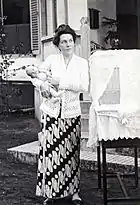
Indo kebaya is also known as kebaya Noni, derived from the term noni or nona which literally means "miss" to refer a young girl or unmarried woman of European descent.[30] During the Dutch East Indies era of Indonesia, Indo (Eurasian) women also colonial European women of high status adopted the kebaya, which provided less restrictive and cooler clothing, as a formal or social dress. Colonial ladies abandon their tight corset and wear light and comfortable undergarment under their kebaya. Indos and colonials probably adopted kebaya inherited from the clothing worn by Njai, native women kept as housekeepers, companions, and concubines in the colonial households. Njai ladies were the ancestors of Indo people (mixed European and Asian ancestry).
The cut and style of kebaya worn by the Dutch and Indo ladies were actually derived from Javanese kebaya. Nevertheless, there are some slight differences, European women wore shorter sleeves and total length cotton in prints, adorned with laces often imported from Europe. The kebaya worn by colonials and Indo ladies mostly are white and has light fabrics, this was meant to provide pleasant and cooler clothing in hot and humid tropical climate, since dark colored fabrics attract and retain heat.
The day kebaya of the Indo people was of white cotton trimmed with oriental motif handmade lace, either locally made in East Indies, or imported from Bruges or the Netherlands. While black silk kebaya is used for evening wear.
Encim or Peranakan kebaya

In Java, the kebaya worn by ladies of Chinese ancestry is called kebaya encim, derived from the name encim or enci to refer to a married Chinese woman.[44] It was commonly worn by Chinese ladies in Javan coastal cities with significant Chinese settlements, such as Semarang, Lasem, Tuban, Surabaya, Pekalongan and Cirebon. Encim kebaya is also adopted as the traditional costumes of Betawi people of Jakarta,[45] thus it is no longer worn solely by Chinese Indonesians, but also by local Betawi people. It marked differently from Javanese kebaya with its smaller and finer embroidery, lighter fabrics and more vibrant colors, made from imported materials such as silk and other fine fabrics. The encim kebaya fit well with vibrant-colored kain batik pesisiran (Javan coastal batik).[30]
It was this encim kebaya from coastal north Java, together with vibrant coloured Javanese coastal batik pesisir that has been exported to Straits Settlements of Singapore and Penang since colonial times in the 19th century, thus created the kebaya wearing culture among nyonyas of Peranakan Chinese in the Malay peninsula. The light and vibrant coloured encim kebaya has become the traditional dress of overseas Chinese ladies in the archipelago, from coastal Java to Sumatran port cities such as Medan, also Singapore, Malacca and Penang, and considered suitable for tropical climate of Southeast Asia.[46]
Varieties in Malaysia
Kebaya Melayu/ Kebaya Labuh/ Kebaya Panjang/ Baju Belah
_(14583575210).jpg.webp)
Although Malay women are famous for their Baju Kurung, sometimes, they also appear wearing kebaya. This long-sleeved kebaya resembles Baju Kurung in many ways. The difference is it splits and fits in front of the dress. The original kebaya Panjang was designed to reach the knee with sleeves that were wide and long. This style of kebaya is commonly worn by Malay women in Malaysia and are cherished by society until today.[47] Back in the old days, kebaya was considered common everyday attire for Malay women besides Baju Kurung. However, the status has changed as it is now worn only to formal events and weddings.[47] Still, this style of kebaya continues to grow according to time with its characteristics of a split at the front that is covered with buttons or brooches still remains. In term of fabric choice, Malay kebaya is usually made of traditional textiles like tenun or songket.
Kebaya Riau Pahang/ Kebaya Turki
In Pahang, local style kebaya is known as kebaya Riau Pahang or sometimes also known as Turkish kebaya. The difference between this style of kebaya and other kebayas is that it has a collared and buttoned neck like a Baju Kurung "Cekak Musang".[48] Kebaya Riau Pahang is not just a dress, it is also a sign of the good relationship between the Sultanate of Pahang and the Sultanate of Riau-Lingga in the past.[7] It is said to have originated from Turkey shaped like robe known as "Habaya" where the dress extends to the level of the ankle and splits in front.
Nevertheless, western influence can also be seen in modern wearers where the dress and the level of the sleeves have been shortened. This style of kebaya is usually made of locally produced Pahang woven fabric or songket. The difference in the status of the wearer is shown by the number of buttons. The number for ordinary people is seven while the number for Pahang nobility is nine. The status of the wearers can also be seen by the wearing of jewellery on the chest and scarf on the shoulder.[49]
Kebaya Selangor
Selangor also has its own kebaya. Kebaya Selangor is the result of assimilation through the marriage of Selangor royal family with relatives of Perak and Kedah royal families. In Selangor, the use of long and loose kebaya dress has been seen since the beginning of the 19th century and spread throughout the district of Selangor. Kebaya Selangor also called "The Malay Dress" is matched with sarong cloth and worn when doing daily activities and attending weddings. Among the features of this style of kebaya are four gores at the front, straight, loose and gusseted. The dress also has to reach the knee, folded slightly around the neck and pinned with a brooch.[50]
Kebaya Selangor is also loose like the traditional Baju Kurung. It is matched with songket, Buginese woven fabrics or batik according to the ability or status of the wearer. Now the use of kebaya Selangor has been varied according to the taste of the wearer. This style of kebaya was once displayed by Michelle Yeoh when attending the Datukship ceremony[51][49] of Sultan Azlan Shah, the Sultan of Perak, in recognition of the fame she brought to the state.[52]
Kebaya Setengah Tiang
Kebaya Setengah Tiang is a traditional clothing of Negeri Sembilan. In the past, this style of kebaya was often used by women when they were at home, visiting wedding ceremonies or working in the fields. Usually, this dress is matched with the use of batik sarong cloth and in the early 1950s, this dress was very popular and often styled in public gatherings. The significant difference between formal and informal occasions is the choice of fabric materials used. During daily activities like working in the field, the dress is usually made of cotton cloth with flower motifs. As for weddings, the dress is made of more expensive fabrics such as brocade, gauze or songket.[53]
This kebaya is known as "Setengah Tiang" (half-pole dress) because it is a little longer than a short kebaya but not as long as long kebaya. This kebaya has nine cut sides representing Negeri Sembilan districts. It has sleeves with volume at the wrist, straight cuts at the bottom and the front of the dress looks like a long kebaya. Women who style this dress will often use brooches, straps and long chains as accessories.[53]
Kebaya Perlis
Kebaya Perlis is very popular during the reign of Raja Syed Alwi. Usually, it is worn by the palace and the state aristocrats during celebrations. Kebaya Perlis if seen from the front view, is similar to the shape of other kebaya but if seen from the back view, it looks like a kebaya that has the same gusset as Baju Kurung with no "bones" on the shoulder. The size of Kebaya Perlis is taken in various parts of the body such as shoulders to waist, waist, back, hem, armpits, hem and wrists. The method of measuring the traditional Kebaya Perlis dress is quite modern.[54]
There are two versions of how to wear Kebaya Perlis, namely folding at the front with a brooch decoration placed on the fold or the dress may not be folded, but instead stacked directly on the fold with a brooch decoration that is diagonally on it. In the past, Kebaya Perlis was made of cotton or Kasarubia. The material of the Kassubian cloth in the past was very different from the cloth available in the market today. The production of Kebaya Perlis requires a relatively soft fabric so that it looks soft on the wearer's body.[55]
Kebaya Kota Bharu
Apart from being famous for Cik Siti Wan Kembang's traditional clothing, Kelantan also has another traditional clothing, namely kebaya Kota Bharu.[7] Named Kebaya Kota Bharu because this style of kebaya is widely worn by women in Kota Bharu and the state of Kelantan as a whole. The difference between the kebaya Kota Bharu and other kebayas is that the front of the kebaya Kota Bharu has extra fabric that connects the left and right side of the kebaya around the chest. Kebaya Kota Bharu is very similar to kebaya Kutu Baru from Indonesia.[48][49]
Kebaya Saloma
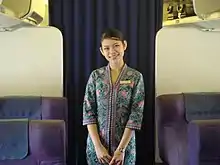
Saloma can be considered as the trigger of the fashion and style trends of Malayan women since appearing as a singer and actress of many adored films.[56] In the 1950s in which the Malayans gripped firmly adheres to the conservatism, Saloma occurs in a dress "alien" for the Malay community at the time. She popularized the fashion that is tights, revealing body shape, chest and cuts across the shoulders. [49] This classic kebaya Saloma is not only becoming a staple for Malayan women at the time but also became an inspiration for the flight attendants of Malaysia Airlines (MAS) and Singapore Airlines (SIA) flight attendants.[56]
Kebaya Nyonya
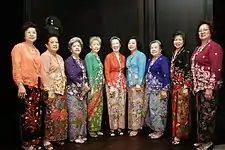
In the straits settlements of Malacca, Singapore and Penang, a different style of kebaya also exists and usually worn by those of Peranakan and Chinese ancestry.[57] The Nyonya kebaya is very unique as it is famous for the use of lace and embroidery[57] that is traditionally worn with matching jewellery and hand-beaded shoes (kasut manek).[58] The Nyonya kebaya is a tighter-fitting sheer embroidered blouse that is traditionally paired with a batik sarong of either drawn by hand or machine-printed with hand-drawn batik cloths from Java are the most sought after materials. Some resources claim that Nyonya kebaya originated from Java, Medan or Surabaya, Indonesia.[59] Nevertheless, similar Nyonya Kebaya can also be found in Phuket and Medan, where they shared the similar Peranakan culture with the historical Strait Settlements.[58]
Kebaya Chetti
Like the Nyonya women, the Chitti Indians also have their own kebaya. There are some differences between the kebaya worn by Indian and Chinese Peranakan. Chitti kebaya is quite conservative in general in favour of opaque material for their kebaya, compared to Nyonya kebaya which prefers semi-transparent fabric. Chitti kebaya also tends to be plainer, with fine or no embroidery at all.[49] The style of wearing kebaya and sarong for Chetti woman is also different from the Malay women. Kebaya wore by Chetti women often have the form of a deduction 'V' neck while Malay women usually straight down.[60] This style of kebaya is also worn with three brooches in various shapes and patterns with the most popular design is a heart shape.[60]
Kebaya Jawi Pekan
In Penang, apart from being popular with Nyonya kebaya, there is also a style of kebaya from the Jawi Peranakan, namely the Indian Muslims such as the Mami and Mamak, where there are differences in the kebaya from these two communities. The Jawi Pekan prefers to use lace embroidered with different sequins while Mamak prefers to use Sari cloth that was directly imported from India to make their Kebaya.[49] The choice of material is largely influenced by the historical ties between the Indian Muslims with India and the Jawi Pekan with their colonial heritage.
Kebaya Kristang
There are two types of kebaya in Kristang community in Malacca, the kebaya kompridu and the dabaia kurtu. Kebaya kompridu means long kebaya while dabaia kurtu means short kebaya. The latter is usually worn by the younger generation.[12] The difference between these two forms of the dress lies in the blouse. Kebaya kompridu is a three-quarter-length blouse while the blouse used with sarong kebaya is short. Both kebayas are fastened with a set of three gold pins (kerongsang) and are worn over a sarong. Both forms of kebaya show Malaysian origin and link the women of the Portuguese Settlement to their neighbours of Baba Nyonya and Chetti Melaka rather than continental Portuguese.[12]
Kebaya Cocos/ Kebayak and Baskat
Cocos Malays of Sabah also have their own traditional style of kebaya. When attending weddings, ceremonies or performing traditional dances, Cocos Malay females are usually dressed in "kebayak", a type of loose and long collarless dress with a curt neckline. The clothing is similar to the kebaya found in various parts of Malaysia but the pattern is heavily influenced by Scotlands. Traditionally, it is worn with batik sarong and "sabuk". The Cocos Malay males also dressed in kebaya-like traditional clothes known as "baskat" during those ceremonies. The male dress designs are almost identical with the woman, but was made shorter and wear along with neck-scarf. [61][62]
Kuyu Kebaya
As one of the indigenous tribes of Borneo, the Murut community also has a unique traditional dress known as Kuyu Kebaya. This dress is made of black coloured velvet fabric and can be divided into two parts, the kebaya and the sarong. In the past, the kebaya was made plain, however, according to change of time, the kebaya is now made with additional stitches of colourful fine beads or with sequins designed with traditional tribal motifs like flower or leaves. Kebaya with decorated beads is usually worn by married women. This style of kebaya is worn by the female dancers during traditional performances at wedding or festivals.[63]
Kebarung
Kebarung is a combination of the acronyms of Kebaya and Kurung. This style of clothing originated from Selangor and was very popular in the early 90s through Malaysia. Its popularity is mainly credited to its loose and long cut top which is preferred by the conservative Malays. It is considered to be both modest and elegant at the same time. Traditionally, textiles such as songket, cottons, and woven fabric were frequently used but imported silk or other textiles may also be used instead. The common accessory is dokoh, a piece of jewellery with three brooches made of tin, gold, or silver. Among the local artists who have been fashion icons of kebarung are Ziana Zain and Erra Fazira.[49]
Political significance
_in_Djakarta_een_congres_dat_door_alle_afdelingen_in_Indonesi%C3%AB_werd_bijgewoond_TMnr_10000216.jpg.webp)
In WWII internment camps of the Japanese occupation of the Dutch East Indies, Indonesian female prisoners refused to wear the western dress allocated them and instead wore kebaya as a display of nationalist and racial solidarity to separate them from fellow Chinese, Europeans and Eurasian inmates.[64]
The only woman present during Proclamation of Indonesian Independence, Dutch-educated activist S. K. Trimurti wore kebaya, cementing it as the female dress of Nationalism.
After Indonesian independence, Sukarno appointed kebaya as a national costume of Indonesian women.[32] Kebayas as the national costume of Indonesian women were often featured by Indonesian first ladies. Fatmawati and Dewi Sukarno, the wives of Sukarno, Indonesia's first president, were known to wear kebaya everyday.
The 21st of April is celebrated in Indonesia as National Kartini Day where Kartini, the female suffragist and education advocate, is remembered by schoolgirls wearing traditional dress according to their region. In Java, Bali and Sunda, it is the kebaya.[11]
The Suharto-era bureaucrat wives' social organisation Dharma Wanita wears a uniform of gold kebaya, with a red sash (selendang) and stamped batik pattern on the kain unique to Dharma Wanita. The late Indonesian first lady and also a minor aristocrat Siti Hartinah was a prominent advocate of the kebaya.
Former President Megawati Sukarnoputri is a public champion of kebaya and wears fine red kebaya whenever possible in public forums and 2009 Presidential election debates.
Modern usage and innovations
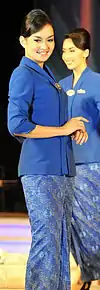
Kebaya has been one of the important parts of oriental style of clothing that heavily influenced the world of modern fashion. Lace dresses are one of the best examples of Kebaya influence.
Apart from traditional kebaya, fashion designers are looking into ways of modifying the design and making kebaya a more fashionable outfit. Casual designed kebaya can even be worn with jeans or skirts. For weddings or formal events, many designers are exploring other types of fine fabrics like laces to create a bridal kebaya.
Modern-day kebaya now incorporate modern tailoring innovations such as clasps, zippers and buttons zippers, being a much appreciated addition for ladies' that promptly need a toilet break, without requiring being literally unwrapped by a helper—to the extent the true traditional kain is near unanimously rejected. Other modern innovations have included the blouse baju kebaya worn without the restrictive kemben, and even the kebaya blouse worn with slacks or made of the fabric usually for the kain panjang. The female flight attendants of Malaysia Airlines and Singapore Airlines also feature batik kebaya as their uniforms.
The female uniform of Garuda Indonesia flight attendants is a more authentic modern interpretation. The kebaya is designed in simple yet classic Kartini-style kebaya derived from 19th century kebaya of Javanese noblewomen. The kebaya made from fire-proof cotton-polyester fabrics, with batik sarongs in parang or lereng gondosuli motif, which also incorporate garuda wing motifs and small dots representing jasmine.[65]
Currently, Indonesia is making efforts for kebaya to be recognised as a Intangible Cultural Heritage to the UNESCO. Efforts including "Selasa Berkebaya" (Tuesday Kebaya) movement among Indonesian women to popularise the daily use of kebaya.[66] However, some conservative Islamic clerics have condemned the movement as a "veiled apostasy", aimed to demote the use of hijab among Indonesian Muslim women.[67] Indeed, some suggests that the kebaya-wearing movement is actually a counter-action against the increasingly conservatism and Arabization within Indonesian society, that warily saw the increase of niqāb-wearing among local women.[68]
Gallery
 European child with sarong and kebaya, early 20th century
European child with sarong and kebaya, early 20th century European woman in sarong and kebaya, early 20th century
European woman in sarong and kebaya, early 20th century Silver kebaya kerongsang pin, the Tropenmuseum collection (c. 1927)
Silver kebaya kerongsang pin, the Tropenmuseum collection (c. 1927)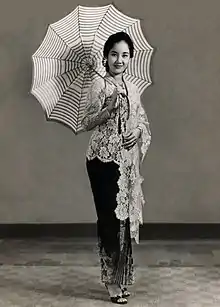 Indonesian movie star Chitra Dewi in kebaya (c. 1960)
Indonesian movie star Chitra Dewi in kebaya (c. 1960)
 Kebaya as national costume representing Indonesia in beauty pageant (2012)
Kebaya as national costume representing Indonesia in beauty pageant (2012) A group of Singapore Airlines flight attendants. The colour of their sarong kebaya represents different ranks.
A group of Singapore Airlines flight attendants. The colour of their sarong kebaya represents different ranks.
![]() Media related to Kebaya at Wikimedia Commons
Media related to Kebaya at Wikimedia Commons
![]() Media related to Tropenmuseum at Wikimedia Commons
Media related to Tropenmuseum at Wikimedia Commons
See also
References
- Welters, Linda; Lillethun, Abby (2018-02-08). Fashion History: A Global View. Bloomsbury Publishing. ISBN 978-1-4742-5365-9.
- Chavalit, Maenmas; Phromsuthirak, Maneepin (2000). Costumes in ASEAN. ASEAN Committee on Culture and Information. ISBN 9747102838.
- Steele, Valerie (2005). Encyclopedia of Clothing and Fashion. Charles Scribner's Sons. ISBN 978-0-684-31395-5.
- Khor, Samantha (23 March 2020). "The Origin of the Kebaya and How It Became an ASEAN Icon". www.ourdaily.co. Ourdaily. Retrieved 17 December 2020.
- Annette Lynch-Mitchell D. Strauss, ed. (2014). Ethnic Dress in the United States: A Cultural Encyclopedia. Rowman & Littlefield. ISBN 9780759121508.
- Setiawan, Ferry (2009). 50 Galeri Kebaya Eksotik Nan Cantik (in Indonesian). Niaga Swadaya. ISBN 9789793927909.
- Phromsuthirak, Maneepin (2000). Costumes in ASEAN Volume 1, Part 1 of ASEAN studies publication series. National ASEAN Committee on Culture and Information of Thailand. ISBN 9789747102833.
- Annette Lynch-Mitchell D. Strauss, ed. (2003). World Eco-Fiber & Textile (W.E.F.T) Forum 2003, Kuching, Sarawak, Malaysia, 19th-21st September 2003. Atelier.
- "Arti kata kebaya - Kamus Besar Bahasa Indonesia (KBBI) Online". kbbi.web.id (in Indonesian). Retrieved 2019-10-10.
- "Women promote 'kebaya' wearing at MRT station". The Jakarta Post. Retrieved 2019-10-10.
- Jill Forshee, Culture and customs of Indonesia, Greenwood Publishing Group, 2006. ISBN 0-313-33339-4, 237 pages
- Patrick Pillai, ed. (2016). Yearning to Belong. Flipside Digital Content Company Inc. ISBN 9789814762007.
- "The Kebaya - An Indonesian Traditional Dress for Women". www.expat.or.id. Retrieved 2019-10-10.
- Denys Lombard (1990). Le carrefour javanais: essai d'histoire globale. Civilisations et sociétés (in French). École des hautes études en sciences sociales. ISBN 2-7132-0949-8.
- Triyanto (29 December 2010). "Kebaya Sebagai Trend Busana Wanita Indonesia dari Masa ke Masa" (PDF) (in Indonesian). Cite journal requires
|journal=(help) - Times, I. D. N.; Khalika, Nindias. "Sejarah Kebaya, Pakaian Perempuan Sejak Abad ke-16". IDN Times (in Indonesian). Retrieved 2019-10-10.
- Haziyah. "Evolusi dan Topologi Pakaian Wanita Melayu di Semenanjung Malaysia" (in Malay). Cite journal requires
|journal=(help) - Pentasari, Ria (2007). Chic in Kebaya (in Indonesian). ESENSI. ISBN 9789790152113.
- S. A. Niessen, Ann Marie Leshkowich, Carla Jones: Re-orienting Fashion: the globalization of Asian dress Berg Publishers: 2003: ISBN 978-1-85973-539-8, pp. 206-207
- Cattoni Reading The Kebaya; paper was presented to the 15th Biennial Conference of the Asian Studies Association of Australia in Canberra 29 June-2 July 2004.
- Michael Hitchcock Indonesian Textiles: HarperCollins, 1991
- "Sejarah Kebaya di Masa Kolonial: Busana Perempuan Tiga Etnis". tirto.id (in Indonesian). Retrieved 2019-10-10.
- "Sejarah di Balik Terpilihnya Kebaya sebagai Kostum Nasional". www.dewimagazine.com (in Indonesia). Retrieved 2021-02-05.CS1 maint: unrecognized language (link)
- tim (18 August 2019). "Jalan Kebaya Terpilih Jadi Busana Nasional Indonesia". CNN Indonesia (in Indonesian). Retrieved 2021-02-05.
- "Disrupsi Budaya di Balik Keindahan Kebaya". indonesia.go.id. 28 August 2019. Retrieved 5 February 2021.
- Panular, P. B. R. Carey, The British in Java, 1811-1816: a Javanese account : a text edition, English synopsis and commentary on British Library Additional Manuscript 12330 (Babad Bĕdhah ing Ngayogyakarta), British Academy by Oxford University Press: 1992, ISBN 0-19-726062-4, 611 pages
- John Pemberton, On the subject of "Java", Cornell University Press: 1994, ISBN 0-8014-9963-1, 333 pages
- Inger McCabe Elliott Batik: Fabled Cloth of Java, Hong Kong: Periplus, 2004
- Mattiebelle Gittinger, To Speak with Cloth: studies in Indonesian textiles University of California, 1989
- Widiyarti, Yayuk (2019-07-17). "Aneka Jenis Kebaya Indonesia, Mana yang Paling Anda Suka?". Tempo (in Indonesian). Retrieved 2019-10-10.
- "Mengenal Jenis-Jenis Kebaya di Indonesia". Go Socio (in Indonesian).
- Adriani Zulivan (4 March 2017). "Benarkah Kebaya adalah Pakaian Asli Indonesia?". Good News From Indonesia (in Indonesian).
- Belia, Aya Prita (2018-12-17). "Ragam Kebaya di Indonesia : Indah, Anggun, dan Klasik". Inspirasi Pagi (in Indonesian). Retrieved 2021-02-04.
- Risdynia, Giza (15 August 2019). "Kenali 7 Jenis Kebaya Indonesia untuk Inspirasi Busana Kondangan Ini". womantalk.com (in Indonesian). Retrieved 2021-02-04.
- "Mengenal Jenis-jenis KEBAYA Indonesia". Milda. Retrieved 2021-02-04.
- Intjelawara, Fitrisiana (2017-05-02). "Mengenal Jenis Kebaya di Indonesia". DeveNews.com (in Indonesian). Retrieved 2021-02-04.
- "Baju Kebaya Labuh, Warisan Budaya Takbenda Indonesia, Kementerian Pendidikan dan Kebudayaan Republik Indonesia". warisanbudaya.kemdikbud.go.id (in Indonesian). Retrieved 2021-02-04.
- "Kebaya Pengantin Batak Kamu Berasal dari Mana?". Wedding Market Artikel (in Indonesian). 2019-09-03. Retrieved 2021-02-04.
- Wima, Pinka (30 September 2018). "15 Busana Adat Batak untuk Tampil Istimewa di Hari Pernikahan". IDN Times (in Indonesian). Retrieved 2021-02-04.
- "Pakaian Adat Ambon". Pemerintah Kota Ambon (in Indonesian). Retrieved 2021-02-04.
- "Pakaian Adat Kabaya, Warisan Budaya Takbenda, Kementerian Pendidikan dan Kebudayaan Republik Indonesia". warisanbudaya.kemdikbud.go.id (in Indonesian). Retrieved 2021-02-04.
- "Jenis-jenis Kebaya di Indonesia dan Cara Membedakannya". Beepdo.com (in Indonesian). 2020-08-23. Retrieved 2021-02-04.
- "Kebaya Kerancang, Warisan Budaya Takbenda Indonesia, Kementerian Pendidikan dan Kebudayaan Republik Indonesia". warisanbudaya.kemdikbud.go.id (in Indonesian). Retrieved 2021-02-04.
- Agnes Swetta Pandia & Nina Susilo (13 January 2013). "Tantangan Bisnis Kebaya Encim" (in Indonesian). Female Kompas.com. Retrieved 19 January 2013.
- Media, Kompas Cyber. "Mengenal Kebaya Encim, Busana yang Identik dengan Perempuan Betawi Halaman all". KOMPAS.com (in Indonesian). Retrieved 2021-02-04.
- Juniman, Puput Tripeni. "Kebaya Encim, Buah Hasil Lebur Budaya Peranakan". gaya hidup (in Indonesian). Retrieved 2021-02-04.
- Zarina Yusof. "Malay Kebaya: The History and Influences of Other Silhoutte". Springer Singapore. Retrieved 31 January 2021.
- Aziz, Azah (2006). Rupa & rupa gaya busana Melayu (in Malay). Penerbit Universiti Kebangsaan Malaysia. ISBN 9789679427554.
- "Jenis-jenis kebaya di malaysia". Alaf21 (in Malay). Retrieved 2021-02-02.
- "Kebaya busana rentas zaman". SelangorKini (in Malay). Retrieved 2021-02-02.
- "Selangor's own kebaya". The Star. Retrieved 2021-02-02.
- "Just Call Me Datuk". Asiaweek. 27 (17). 4 May 2001. ISSN 1012-6244. Archived from the original on 9 May 2001. Retrieved 3 February 2021.
- Zakaria, Alias (2017). Busana Tradisional Negeri Sembilan (UUM Press) (in Malay). UUM Press. ISBN 9789672210191.
- CITRA BUDAYA JKKN BIL. 2/2019 (in Malay). Jabatan Kebudayaan dan Kesenian Negara. 2019.
- "Bringing back Kebaya Perlis". The Star. Retrieved 2021-02-02.
- "Saloma dapat jolokan 'Marilyn Monroe of The East'". BeritaHarian (in Malay). Retrieved 2021-02-02.
- Seri, Datin (2012). Nyonya Kebaya: A Century of Straits Chinese Costume. Tuttle Publishing. ISBN 9781462906918.
- Koh, Jaime (2009). Culture and Customs of Singapore and Malaysia Cultures and Customs of the World. ABC-CLIO. ISBN 9780313351167.
- Koh, Jaime. "Nonya kebaya". Singapore Infopedia. Retrieved 2021-02-05.
- "Pakaian Chetti Melaka". The Malaysian Insider (in Malay). Retrieved 2021-02-02.
- "Busana Pakaian Tradisi Suku Kaum Cocos". Retrieved 3 February 2021.
- Wacana kurator Jabatan Muzium Malaysia (in Malay). Jabatan Muzium Malaysia. 2011. ISBN 9789670372020.
- "Kuyu Kebaya Pakaian Tradisi Murut Brunei". Retrieved 5 February 2021.
- Cattoni Reading The Kebaya paper was presented to the 15th Biennial Conference of the Asian Studies Association of Australia in Canberra 29 June-2 July 2004: 8
- Kompas Female Terbang Bersama Kebaya
- Post, The Jakarta. "#SelasaBerkebaya movement aims to promote 'kebaya' as daily outfit". The Jakarta Post. Retrieved 2019-10-10.
- "Saat Gerakan Berkebaya Dituduh Agenda Permurtadan Terselubung" (in Indonesian). Tirto.id. Retrieved 15 August 2019.
- Latumahina, Jeannie (2018-04-04). "Puisi Sukmawati Gerakan Keadilan budaya". Media Kritis Anak Bangsa (in Indonesian). Retrieved 2019-10-10.
External links
| Wikimedia Commons has media related to Kebaya. |
